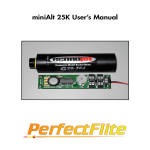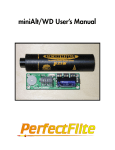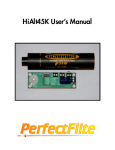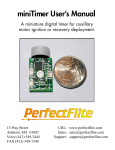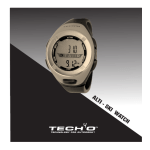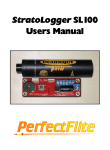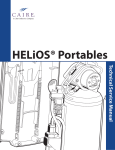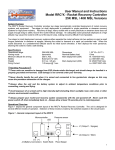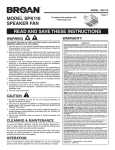Download microAlt 4600/9200 User`s Manual
Transcript
microAlt 4600/9200 User’s Manual microAlt 4600/9200 User’s Manual A subminiature data logging altimeter with two event deployment capabilities for small to medium sized rockets. 15 Pray Street Amherst, MA 01002 Voice (413) 549-3444 FAX (413) 549-1548 URL: www.perfectflite.com Sales: [email protected] Support: [email protected] Contents Preface ................................................................................... 1 Theory of Operation ................................................................ 2 Preliminary Setup .................................................................... 3 Getting to know your altimeter ........................................................... Battery installation ............................................................................. Ground level calibration ..................................................................... Audio reporting format ...................................................................... 3 4 4 5 Installation Basic payload module ........................................................................ Sampling hole size chart .................................................................... Altimeter mounting ............................................................................. Adding recovery device deployment ................................................... Apogee-only deployment ................................................................... Dual-event deployment....................................................................... 6 7 7 8 8 9 Additional Installation Ideas Removeable modular system ............................................................ Plug-in ejection charges .................................................................... Single rechargeable battery ............................................................. Remote switches ............................................................................... 10 12 12 13 Ejection Charges Ejection charge igniters .................................................................... 14 Making ejection charges ................................................................... 14 Operation Sequence of events ........................................................................... 15 Preflight checklist ............................................................................. 18 On-ground testing ............................................................................ 19 Cautions ................................................................................ 19 Appendices ............................................................................ 20 Congratulations on your purchase of the new microAlt rocketry altimeter. Please read these instructions carefully before attempting to use the altimeter to insure safe and successful operation. Your new altimeter provides several useful functions: ➢ Peak altitude determination. After a flight with the altimeter installed, your rocket’s peak altitude (apogee) will be reported via a series of audible beeps. This will allow you to study the effect of various design parameters (fin/nose cone shape, fin airfoil, number of fins, etc) on your rocket’s performance. It can also be used by clubs for altitude contests - compete to see who can get the most altitude out of a given engine size, etc. ➢ Electronic deployment of recovery devices. The altimeter provides electronic outputs for firing ejection charges at two levels: apogee and 300 feet above ground level (440 feet for microAlt 9200). Firing the first charge exactly at apogee insures that your recovery system is deployed while your rocket is traveling at the slowest speed possible. This minimizes the possibility of rocket damage due to “zippered” body tubes and “stripped” parachutes which occur when deployment occurs at higher velocities. Electronic deployment is preferable to using the engine’s built-in timed ejection charge, which can vary from engine to engine and is usually limited to two or three specific time delays (which may not be optimal for your particular engine/rocket combination). While it is often adequate to use single-event ejection at apogee, a two-event deployment option is also provided. This involves ejecting a small parachute or streamer at apogee, allowing your rocket to fall at a fast but controlled rate to the second deployment level of 300 or 440 feet AGL. At this point a (larger) main chute is deployed to bring your rocket slowly and safely down for a soft landing. This has the significant advantage of reducing the distance your rocket drifts on windy days, making safe recovery easier and more certain. ➢ Download of flight data to a personal computer. After recovery, you can connect your altimeter to an IBM compatible or Macintosh computer with the optional data transfer kit. This allows you to view a graph of altitude vs. time for the first 19 seconds of flight. The data are also saved as a standard text file which can be imported into spreadsheet programs for further analysis (velocity, acceleration, sink rate, etc). 1 Theory of Operation The microAlt altimeter determines altitude by sampling the surrounding air pressure during flight and comparing it with the air pressure at ground level. As the altitude increases, the air pressure decreases, and the onboard microprocessor converts the pressure difference to altitude. When the altimeter is turned on, it looks at the “CAL” (calibrate) switch and enters calibrate mode if the switch is on. The calibrate mode continuously reports the current altitude, and the calibration potentiometer is then used to set the altitude of ground level. Since the ambient barometric pressure changes with normal weather fluctuations, this calibration should be checked before using the altimeter. The altimeter works on a “relative pressure” principle, so setting the exact ground level is not necessary, but getting it close will improve accuracy by shifting the non-linear altitude/pressure response curve into the proper range. If the altimeter is turned on with the “CAL” switch in the off position, it enters normal mode. The first thing that it does is check the barometric pressure sensor to make sure that the reading is within normal limits. If an abnormal condition is detected, an error is reported. If pressure readings are normal, the status of the ejection charges’ power and continuity conditions are checked and reported for a period of 30 seconds. At the end of this interval, the ground level altitude is sampled and reported. The microprocessor then awaits launch by looking for a sudden decrease in pressure as the rocket rises. During this waiting period the ground level will be updated if a slow change is detected to compensate for thermal and barometric drift. When the altitude exceeds a preset threshold in a short period of time, launch is detected and data sampling begins. Pressure readings are taken every 200ms (five readings/second) and converted to altitude above ground level. The altitude results are saved in memory for later retrieval, and are also inspected to determine apogee (peak altitude). When the derived ascent rate decreases to zero, apogee is detected and a power MOSFET is turned on to supply power to the apogee event ejection charge igniter. Altitude readings continue to be recorded during descent, and are compared with a main deployment threshold of 300 feet above ground level (440 feet for microAlt 9200). At this point another power MOSFET is turned on to supply power to the main parachute ejection charge igniter. When the main parachute is deployed and the sampling memory is full, the peak altitude is reported continuously at eight second intervals via a sequence of beeps. After recovery, an accessory cable can be connected to the data output, and turning the CAL switch “on” will then send the sampled flight data in serial RS-232 format to a host computer for storage and inspection. Switching the CAL switch back “off” will resume the peak altitude annunciation. 2 Getting to Know Your Altimeter: Refer to figure 1 below to identify the following items: A) Power switch B) Calibrate switch C) Ejection charge power connector D) Main battery holder E) Ground level calibration potentiometer F) Apogee ejection output connector G) Main ejection output connector H) Pressure sensor element I) Audio beeper Figure 1 3 Battery Installation Before inserting the battery, check to see that the battery holder end terminals are bent slightly inward as shown in figure 2. When viewed from the side the battery contact points should be almost even with the ends of the retaining clips. Insert four SR44/357 Silver Oxide cells into the provided insulating sleeve as shown in figure 3. Do not attempt to use Alkaline cells, as they have a lower discharge voltage and will not work reliably in the altimeter. Check to make sure that the insulating sleeve is not torn or damaged; replace the sleeve if any problems are noted. Insert the battery pack into the battery holder (d) with the “+” terminal (flat end) towards the pressure sensor element (h). Correct polarity is also marked on the circuit board. Insure that the battery is properly centered and not offset forwards or backwards in the holder. An offset battery will reduce the battery terminal contact force and could cause an intermittent connection. Warning: When the battery is inserted into the holder, the metal ends of the holder are “live”. Do not allow metal objects to short-circuit the two battery holder clips together, or the battery will be drained rapidly and excess heat will be generated. Figure 2 Figure 3 Ground Level Calibration Using a pen or other pointed instrument, move the Calibrate Switch (b) to the “on” position. This will allow you to set the ground level reading to compensate for barometric pressure variation. Now move the Power Switch (a) to the “on” position. You will hear a long beep, followed by a pattern of shorter beeps. The beeps are reporting four digits of the current altitude in feet - a series of beeps for the first digit (thousands of feet), a short pause, another series of beeps for the next digit (hundreds of feet), etc. Ten beeps are used to indicate the number zero (if zero beeps were used, you would not be able to differentiate between 2200 feet and 0220 feet!). Slowly adjust the Calibration 4 Potentiometer (e) with a 2.0mm jewler’s screwdriver until the pattern of beeps accurately represents your current ground level. Turning the screwdriver clockwise will raise the reported number, and turning it counterclockwise will lower it. It is not necessary to set the ground level exactly, but getting it close will improve overall accuracy. It is imperative that the ground level be set to a number greater than 0 (sea level) or the altimeter will not operate properly. You should make sure that you check your ground level reference before each flight. After setting the ground level, move the Power and Calibrate Switches to the “off” position. Note: If you do not want to bother with ground level calibration, or if your mounting method precludes easy access to the calibration potentiometer, there is an alternative. Simply adjust the potentiometer to its maximum clockwise rotation so that ground level will be greater than zero for all weather conditions. Overall accuracy and maximum altitude over ground level will be reduced slightly for the sake of convenience. Many other altimeter manufacturers skip the ground level adjustment altogether in this manner. Digit Reported as: 0 beep-beep-beep-beep-beep-beep-beep-beep-beep-beep 1 beep 2 beep-beep 3 beep-beep-beep 4 beep-beep-beep-beep 5 beep-beep-beep-beep-beep 6 beep-beep-beep-beep-beep-beep 7 beep-beep-beep-beep-beep-beep-beep 8 beep-beep-beep-beep-beep-beep-beep-beep 9 beep-beep-beep-beep-beep-beep-beep-beep-beep As an example, 2560’ would be reported as: long beep-pause-beep-beep-pause-beep-beep-beep-beep-beep-pause-beep-beep-beep-beep-beep-beeppause-beep-beep-beep-beep-beep-beep-beep-beep-beep-beep-long pause 5 Installation Basic record-only mode Your altimeter needs to be installed in a separate payload compartment, sealed from the pressure and heat of the ejection charge gasses. It is not OK to tie it to the shock cord and pack it in with the chute! The high pressure and heat encountered during ejection would damage the delicate pressure sensor’s diaphram. If you are not using the electronic ejection features and are just interested in altitude recording/data collection, the simplest mounting method involves adding a sealed payload compartment to your rocket. This is just a section of body tube behind the nosecone with a sealed tube coupler connecting it to the main body tube (see figure 4). Some rockets already have such a payload section, and one can be added easily if yours does not. Loose fit Glue Tight fit Wadding Sampling hole Altimeter Figure 4 microAlt 4600 in payload compartment of Estes Nova Payloader 6 You must drill a clean-edged hole in the payload section to allow outside air pressure to be sampled by the altimeter. This hole should be as far away from the nosecone and other body tube irregularities as possible (3X the body tube diameter or more) to minimize pressure disturbances being created by turbulent airflow over the body tube. Sand the area around the hole as necessary to eliminate flashing or raised edges. Exact sizing of the hole is not critical, refer to the following table for suggestions: Payload Section Size vs. Sampling Port Hole Size Diameter Length Hole Size 1” 5” .031” (1/32”) 1.6” 6” .047” (3/64”) 2.1” 6” .078” (5/64”) 2.1” 12” .156” (5/32”) 3.0” 12” .219” (7/32”) 3.0” 18” .344” (11/32”) Other “D” Other “L” H=D*L*.006 While not strictly necessary, the single sampling hole can be replaced by several smaller holes can be distributed around the airframe’s circumference. This will minimize the pressure variations due to wind currents perpendicular to the rocket’s direction of travel. If you are not using additional batteries or ejection charges, mounting is not critical. Simply place the altimeter in the payload section - it does not matter which end of the altimeter faces “up”. Use pieces of foam rubber in front of and behind the altimeter to prevent it from shifting under acceleration and deceleration. A wrap of foam weatherstrip around the battery portion of the altimeter will provide a snug fit in 24mm/BT50 size body tubes, and a “sleeve” made out of standard foam pipe insulation can be used for larger size tubes. Make sure that your foam rubber pieces do not block the path from the air sampling hole to the altimeter’s pressure sensor element. A channel can be cut in pipe insulation for this purpose; make sure that the channel lines up with the sampling hole and the sensor’s air inlet. Your payload section should close securely so that the altimeter is not “ejected” upon motor burnout deceleration or chute deployment shock. 7 Setting up the altimeter for use as a recovery device with apogee-only or two-stage deployment is necessarily more complex. You may want to gain some experience with your altimeter in “recording only” mode before using it for deployment. Then begin with a simple apogee-only deployment application, and move on up to two-stage deployment after you’ve gained experience with electronically-fired ejection charges. The following suggestions can be used as a “starting point”, and should be adapted to suit your specific application. A sampling of additional ideas follows, including different power sources, “plug-in” ejection charges, and a flexible mount that can be shared among many rockets. To insure the highest degree of safety, all recovery systems should be ground-tested prior to launching. Using redundant backups (e.g. motor ejection charge in addition to electronic deployment) is always a good idea whenever possible. Installation with apogee deployment Installation with apogee-only electronic deployment is similar to the standard installation noted above. The altimeter is mounted in the sealed payload compartment along with an ejection charge battery, and a small hole is drilled through the rear bulkhead for the ejection charge cable (see figure 5). Route the ejection charge cable through the bulkhead with the altimeter connector end in the payload section, leaving sufficient wire aft of the bulkhead to allow connection of the ejection charge. Seal the point where the ejection charge cable passes through the bulkhead with silicone, epoxy, or hot melt glue to prevent ejection charge pressure from entering the payload compartment. Make sure that the altimeter, battery, and wires are mounted securely so they will not shift under the high G forces experienced during acceleration and burnout/deceleration. Leave some slack in the cables to prevent the plugs from pulling out of the connectors if things do shift. Prior to launch you will attach the ejection charge’s leads to the loose ejection charge cable ends, twisting them tightly and taping them to prevent shorts. The ejection charge will then be loaded into the rocket’s airframe immediately in front of the motor, with flameproof wadding inserted after it to protect the chute. Pack the chute next, being careful to position the shroud lines and shock cord away from the ejection charge cable to minimize the likelihood of tangling. Then join the main airframe and payload sections, making sure that they are sufficiently loose to allow separation when the ejection charge fires. The altimeter should not be switched ON and “armed” by plugging in the ejection charge battery until your rocket is loaded onto the pad to prevent wind gusts, etc from prematurely firing the ejection charge. See the Preflight Checklist section for more details. 8 Choose a motor with a delay that is a few seconds longer than you would normally use with the specific motor/rocket combination. The motor’s charge will then serve as a backup in the event of a primary ejection malfunction. Seal cable here Ejection charge Loose fit Glue Tight fit Wadding Sampling hole Altimeter and eject battery Figure 5 Installation with dual event deployment Again, there are many possible variations of the following installation scheme. Careful attention to the design of your installation will make the difference between a successful installation and a failure. Ground test your setup before launching to insure proper separation and deployment of recovery devices. The basic premise is that you want two separable parachute compartments and a single sealed electronics bay. Perhaps the simplest method involves a basic setup similar to the apogee deployment system described above, with an additional sealed chute compartment behind the nosecone (see figure 6). A small parachute or streamer is ejected from the compartment aft of the payload/electronics section at apogee, and a larger chute is ejected from the compartment between the payload section and nosecone at a lower altitude (300’ or 440’ AGL). The ejection cable leading into the forward parachute compartment should be sealed in the same manner as the aft one to prevent ejection gas entry into the payload compartment. Two additional precautions should be made: First, the joint between the payload section and the forward parachute compartment should be either a very tight friction fit or preferably a positive-retention system like screws or retaining pins can be employed. This will prevent the shock of the main chute deployment from separating this joint and ejecting the electronics. Second, the fit of the nosecone to the upper parachute compartment should be tight enough to prevent inadvertent separation at apogee, but loose enough to allow separation upon main chute ejection charge firing. 9 Seal cable here Apogee/drogue ejection charge Loose fit Seal cable here Tight fit Main chute ejection charge Glue Glue Drogue chute Main chute Wadding Wadding Altimeter and eject battery Sampling hole Figure 6 Other Installation Notes After gaining some experience with the microAlt altimeter you may want to try some more elaborate mounting and wiring systems. A few suggestions follow: Removable modular system The altimeter and a three to five cell NiCad ejection battery will fit side by side within a standard 4” length of 38mm coupler tubing with room to spare (a longer section of 24mm or 29mm coupler can also be used if the components are mounted end to end). A 36mm bulkhead is glued to the front end of the coupler tube, and a short section of 38mm airframe tube and a 43mm bulkhead glued together form a “cap” for the aft end. Two sections of 4-40 threaded rod and appropriate hardware hold the cap on, and a rubber Oring inside the cap provides a seal against ejection gas entry. If remote switches are added (see below), the altimeter and a 5 cell battery pack can be semi-permanently affixed with hot melt glue to the ID of the coupler tube. A 3/8” hole drilled in the side of the coupler will allow access to the calibration potentiometer and will provide a path for sampled air from outside the rocket’s airframe. Two 1/8” holes drilled in each of the bulkheads with 4-40 brass machine screws and appropriate hardware will allow external connection of ejection charges without gas leakthrough. Solder the altimeter’s ejection charge cables to the screw heads inside the altimeter unit, and connect the ejection charges to the external threaded portion of the screws with nuts and lugs. If the main chute compartment is fitted with two centering rings and a short section of 38mm tube, the completed altimeter package will slide right in. A 3/8” or larger hole should be drilled in the 38mm tube to line up with the hole in the altimeter package, and the outside air sampling hole is drilled in the outer airframe between the centering rings. A wrap of masking tape around the 38mm tube and the altimeter unit cap will hold the altimeter in when the main ejection charge fires. For larger rockets, skip the 38mm tube part of the cap and make the aft bulkhead larger. The bulkhead can be screwed down against the rear centering ring, providing positive retention against larger ejection forces. 10 A removeable modular altimeter bay Bay with rocket Bay installed 11 Plug-in ejection charges Installing the main ejection charge can be made simpler still by gluing a short section of 1/2” launch lug material to the front bulkhead of the altimeter unit. Bend two small strips of shim brass about 3/8” wide by 1” long into a “U” shape so that they fit snugly over the lip of the exposed end of 1/2” launch lug. Using a pair of needle nosed pliers, bend the brass so that it confoms to the radius of the launch lug. When you are satisfied with the shaping of the brass, epoxy the strips in place, being careful to keep the epoxy off of the exposed faces of the brass. Solder the main ejection wires to the two brass strips, and apply more epoxy to provide additional strength and strain relief to the wires. You now have a “socket” that ejection charges can be “plugged” into. Your ejection charges should have short leads running down their sides, separated by 180°. Standard Estes igniters work well in this application. Prepping the main ejection charge now takes just seconds–simply press it into place! Charge installed Socket with ejection charge Single rechargeable battery A five cell 6 volt NiCad battery pack can be used in place of both the main and ejection charge batteries to eliminate the disposable main battery. Carefully unsolder and remove the battery clips from the altimeter PCB, and connect the wires from the NiCad pack to the outermost mounting clip holes. Make sure that you observe polarity or the altimeter will be damaged. The second (innermost) set of battery clip holes can then be used for a charge cable. To supply power for the ejection charges, route a wire from the NiCad 12 positive terminal to the red lead of the ejection charge power connector through a remote arming switch. The black wire in the ejection charge cable is not needed since it is common with the altimeter power negative from the NiCad battery. Remote power and CAL switches The ON/OFF and CAL switch assembly can be removed if you want to add remote switches for these functions. Carefully unsolder and lift off the switch assembly, and solder wires from standard SPST switches to the exposed solder pads. The ON/OFF switch is connected to the pads nearest the “ON” and “PWR” designations, the CAL switch is connected to the remaining two pads. Check your solder joints carefully for integrity and lack of bridges to adjacent points, and then seal the wires with a bead of hot melt glue for strain relief. Note: If your switches penetrate either of the bulkheads into the ejection areas, make sure that they are sealed to keep ejection gasses out of the altimeter area. You may want to use switches with long PCB-type leads so that the entire switch is outside the payload section. The leads can then run through sealed holes in the bulkhead and be soldered to wire connections inside. If your switches will be exposed to ejection gasses, you may want to protect them with some sort of cover. The cover will also help keep the switches from being inadvertently flipped by possible impact during ejection. 13 Ejection charges The ejection charges used to deploy your recovery devices can be purchased commercially (see appendix) or made at home. Since ejection charges contain a quantity of explosive black powder, extreme care must be exercised while constructing and handling them. Keep your face and hands away from the end of any ejection charge that has been loaded with powder! Do not look into or reach inside rocket airframes with live ejection charges loaded, and keep in mind that an accidentaly- ejected nosecone can severely damage anything in its path. Several kinds of ejection charge igniters are suitable for use with the microAlt altimeter. Standard Estes igniters work well and are readily available (put a dab of epoxy with glass microballoon thickener between the tape and the igniter tip to make them more durable). Commercially available electric matches can also be used, a listing of several appears in the appendix. Flashbulbs are sometimes used, but are fragile, expensive, bulky, and prone to accidental triggering by weak electrical currents. Since the igniter will be in direct contact with the ejection charge’s black powder, all that is really needed is a thin wire element that glows red-hot when a current is passed through it. Basic ejection charges can be made in the following manner. Cut a section of cardboard tube (the tubing from shirt hangers works well) about 1” long, and use hot-melt glue to fill in a plug at one end. Work the glue in from the end that you want to plug, rotating the tube between your fingers until a solid seal is attained. Set the tube (glue end down) on a piece of paper until the glue cools. When cool, cut away the excess paper and inspect the plug for uniformity of thickness (3/16” to 1/4” is good) and lack of holes. Insert your ejection igniter in the open end of the tube, being careful to not damage the delicate ignition element wire. Bend the lead wires over the lip of the tube and use masking tape to secure them to the outside of the tube. Set the tube/igniter assembly down, open end up, to prepare for the addition of black powder. Making a stand out of a small block of wood with appropriately-sized holes drilled in it will hold your tubes more securely during the filling/sealing operation. Add the appropriate amount of FFFFg black powder (multiply the volume of the parachute bay in cubic inches by .01 to get grams of black powder) and gently tap the side of the tube to distribute the black powder around the igniter head. Using a section of 1/8” wooden dowel, carefully press a small ball of flameproof wadding in on top of the black powder so that the powder is completely covered. Do not press too hard or you may damage the igniter element. Seal the end of the ejection charge with melted wax or a disc of tape. The purpose of the seal is simply to hold the powder in. You do NOT want to 14 use something stronger like epoxy, which would make the tube rupture upon ignition, possibly damaging your rocket’s airframe. Using a wax or tape seal will keep the ejection charge tubing intact, so that it can be reloaded and reused. If you use molten wax, melt the wax using a flameless method (not a candle!) and keep it away from any open containers of black powder. Your ejection charge is now complete. Store loaded ejection charges in a safe manner, with the igniter wire ends shorted together until immediatly prior to use. Since the actual amount of black powder necessary can vary based on a number of parameters (powder type, nosecone/coupler to tube friction, etc) you should test your ejection charges on the ground before flight. Start with a little less powder, and increase the amount until the airframe separates reliably. Then add 50% as a safety factor to account for variations in friction due to humidity, etc. Operation To insure proper operation of your altimeter and any associated deployment systems, you must observe and adhere to the following sequence of events. If you launch before the altimeter is ready, ground level will not be sampled properly and deployment and data logging will not function properly. If you forget to arm your ejection charges, the recovery devices will not be deployed and serious rocket/property damage can occur. Sequence of events Before prepping your rocket, move the altimeter’s CAL switch to the ON position and turn the altimeter ON. Listen to the reported ground level, and adjust the ground level calibration potentiomenter until the reported ground level is approximately equal to the actual ground level (in feet above sea level). The reported ground level must be above zero (sea level) for the altimeter to function properly. After the calibration is complete, turn OFF the power and CAL switches. Prepare your rocket and install the engine before setting up the altimeter. Do not install the igniter into the engine until you are at the launch pad. If you are not using electronic deployment (just using altitude reporting/data logging functions) you can ignore the sections of the following text that deal with ejection charges. If you are using electronic deployment, the apogee and main ejection charges and associated igniters should be loaded into your rocket and the wires connected to the altimeter’s ejection charge cables. The ejection charge battery should not be connected at this time, 15 so the system will be in a “disarmed/safe” state. Make sure that the apogee and main ejection charge cables are not exchanged, and that the wires are not shorting together or to any conductive objects. Also insure that adequate wadding or other protection is used to prevent the hot ejection charge gasses from burning your parachute and shock cord. At this point you can have the RSO inspect your rocket (if applicable) and proceed to the launch pad. Install the igniter in the engine and place the rocket on the launcher. Open the payload compartment and make sure that the altimeter’s CAL switch is OFF, and that the ejection charge battery’s power cable is NOT connected to the altimeter. Plug the ejection charge cables into the connectors on the altimeter, making sure that the “apogee” and “main” cables go to the correct connectors on the altimeter. Do not exchange these cables or your main chute will deploy at apogee! Leave some slack in these cables so that they will not be pulled out if the altimeter shifts position slightly during acceleration/ deceleration. Turn the power switch ON - you should hear a single beep from the altimeter. If you hear a continuous tone, the ground level has not been set properly (in the CAL procedure above) or the altimeter’s sensor is damaged. Do not attempt to launch if this condition exists! Next you will be “arming” the ejection charges. From this point on you should exercise extreme caution, as you will be working with live charges. Keep your hands, face, and other body parts away from the ejection charges and the nosecone. If the charges should blow prematurely, you do not want to be in the path of the forcefully ejected nosecone or payload section. Plug the ejection charge battery cable into the ejection power (larger) connector on the altimeter. This provides primary “arming” for the ejection charges. Secondary arming occurs after the altimeter detects launch conditions (120’ or 200’ AGL altitude). If you have ejection charges connected properly, the altimeter will signal continuity with a series of beeps. A single beep every second indicates proper continuity on the apogee charge, two beeps indicates continuity on the main charge, and three beeps indicates continuity on both charges. If continuity is being reported as expected, you should close the payload compartment at this time. If continuity is not reported as expected, disconnect the ejection charge battery (disarm the system), turn the altimeter power switch OFF, and correct the problem. Do not launch if continuity is not reported properly! The continuity beep annunciation will continue for approximately 30 seconds, at which time ground level is reported and the system becomes silent as it awaits launch detection. 16 Note: If the altimeter is installed in a compartment that becomes slightly pressurized as a coupler is inserted into the body tube, make sure that you close the compartment early enough that the pressure will equalize through the sampling hole before the 30 second continuity check is complete. If the is not done, ground level could be sampled incorrectly, leading to premature launch detection. After the ground level has been reported and the altimeter is silent, connect the engine’s igniter to the launch system. Your rocket is ready to launch! Warning: Launching your rocket before the ground level has been established and reported will result in failure. Always wait until you hear the ground level report before allowing your rocket to be launched. When you recover your rocket, the altimeter will be beeping to report the peak altitude attained. If you want to extract the flight data, leave the altimeter’s power swicth ON and disconnect the ejection cables (if used) from the altimeter. Plug the data transfer cable into the ejection charge power (larger) connector on the altimeter, and plug the other end of the transfer cable into your computer’s serial port. Run the data transfer program on your computer, and move the CAL switch to the ON position when prompted to do so. The altimeter will stop beeping and data will be transferred to the computer. When the program reports that the transfer is completer, the altimeter can be switched OFF. 17 Preflight Checklist ❏ Check main battery voltage using an accurate voltmeter with the altimeter switched ON. Terminal voltage should be greater than 5.70V. Replace battery if voltage is lower. ❏ Turn altimeter OFF. Turn CAL switch ON. Turn altimeter ON and set/verify ground level (close to true ground level, greater than zero). Turn altimeter OFF. ❏ Prep rocket, install engine, do not install engine igniter. ❏ Install ejection charges (if used) and wadding/chute protection. ❏ Connect ejection charge leads to ejection charge cable ends, making sure that wires do not short together or short to anything else. ❏ Have your rocket inspected by RSO if applicable, install engine igniter, and place rocket on launch pad. ❏ Open payload compartment and make sure that: ❏ CAL switch is OFF ❏ ejection charge power cable is NOT plugged into altimeter. ❏ Plug apogee and main ejection charge cables into altimeter. Make sure cables are not swapped. Leave some slack in cables. ❏ Turn altimeter power switch ON. You should hear a single beep. If you hear a continuous tone, turn altimeter OFF and recheck ground level calibration. ❏ Plug ejection charge battery cable into larger connector on altimeter. Leave some slack in cable. Ejection charge continuity will be annunciated by a series of one, two, or three beeps. Ejection charges should be considered to be “armed” at this point and body parts kept clear! ❏ Close payload compartment within 30 seconds of powering ON altimeter and wait for continuity beeps to cease. Ground level will be reported once, then altimeter will be silent. ❏ After ground level has been reported and the altimeter is silent, attach launch system leads to engine igniter and launch! 18 Testing A simple apparatus for ground-testing the entire ejection system can be made with a small (~1” dia) plastic suction cup and a 15 feet of 1/8” plastic hose. Drill a hole in the center of the suction cup and insert one end of the plastic hose. Glue hose in place if friction fit is not achieved. Tape the suction cup to the outside of the rocket’s airframe such that the air sampling hole in the airframe lines up with the plastic hose i.d. Prep the recovery system as in the checklist above, omitting the rocket engine and its igniter. Place the rocket on a slightly angled launchpad, with the nosecone pointing away from people and other objects. After the system is armed and closed, wait for the altimeter to become silent, and then suck on the free end of the plastic hose to create a low pressure region within the payload compartment. The altimeter will sense this as a launch condition. When you stop sucking on the hose, the altimeter will sense apogee and the payload section should be ejected from the booster. As you release the vacuum from the hose, the altimeter will sense the lower apparent altitude and will eject the nosecone from the payload section. If the sections do not separate with a reasonable amount of force, additional black powder should be added to the ejection charges to insure reliable separation. Cautions • Do not touch circuit board traces or components or allow metallic objects to touch them when the altimeter is powered on. This could cause damage to your altimeter or lead to premature ejection charge detonation. • Exercise caution when handling live ejection charges - they should be considered to be explosive devices and can cause injury or damage if handled improperly. • Do not expose altimeter to sudden temperature changes prior to operation. The resulting circuit drift could cause premature ejection. • Do not allow strong wind gusts to enter the airframe pressure sensing hole - this could cause premature launch detection and ejection. • Do not allow the altimeter to get wet. Only operate the altimeter within the environmental limits listed in the specifications section. • Check battery voltage before each flight and replace if below 5.70V while “on”. • Confirm proper battery installation before powering ON: Polarity, centering and contact force. 19 • Do not allow external objects to short-circuit battery clips. • Do not rupture pressure sensor diaphragm with excessive pressure or sharp object. • Always follow proper operational sequencing as listed in preflight checklist. Appendix Igniter Sources: Estes Industries. ................................................ EST2301 Igniter 1295 H Street Penrose, CO 81240 Countdown Hobbies (dealer) 7 P.T.Barnum Sq. Bethel, CT 06801-1838 (203)790-9010 www.countdownhobbies.com Luna Tech ........................................................... Oxral 148 Moon Drive Owens Cross Roads, AL 35763 (256) 725-4224 www.pyropak.com Daveyfire ........................................................... Daveyfire 7311 Greenhaven Drive, Suite 100 Sacremento, CA 95831-3572 (916) 391-2674 Performance Hobbies (dealer) 442 Jefferson Street NW Washington, DC 20011-3126 (202) 723-8257 www.performancehobbies.com Firestar ............................................................... Firestar Electric Match P.O. Box 533 New Haven, IN 46674 FAX (219) 749-9840 Rocketflite .......................................................... Magnelite 836 Houston Drive New Haven, IN 46674 FAX (703) 783-5838 20 Specifications microAlt 4600 dimensions: weight: operating voltage: operating current: eject charge battery voltage: firing current: continuity check current: maximum altitude: launch detect: event 1 output: event 2 output: sample interval: number of samples: serial data format: altitude accuracy: operating temperature: 0.80”W x 2.60”L x 0.70”T 19 grams (with battery) 6.0V nominal (10V max) 7 ma typical 3.6V to 20V 11A for 100ms, 6A for 1000ms 100µA/V 4600 feet MSL 120 feet AGL apogee 300 feet AGL 200 ms 96 5V RS-232, 9600 baud, N-8-1 +/- 1% typical 0C to 70C microAlt 9200 dimensions: weight: operating voltage: operating current: eject charge battery voltage: firing current: continuity check current: maximum altitude: launch detect: event 1 output: event 2 output: sample interval: number of samples: serial data format: altitude accuracy: operating temperature: 0.80”W x 2.60”L x 0.70”T 19 grams (with battery) 6.0V nominal (10V max) 7 ma typical 3.6V to 20V 11A for 100ms, 6A for 1000ms 100µA/V 9200 feet MSL 200 feet AGL apogee 440 feet AGL 200 ms 96 5V RS-232, 9600 baud, N-8-1 +/- 1% typical 0C to 70C 21 Connector Pinouts: Apogee Igniter J1, Main Igniter J2 Ejection Power/Data Link J3 Pin 1: Switched (-) Pin 1: Ejection charge power (+) Pin 2: Power (+) Pin 2: Data out Pin 3: Handshake in Pin 4: Ground 22 Warranty All assembled Perfectflite products include a full three year/36 month warranty against defects in parts and workmanship. All Perfectflite kits include a full three year/36 month warranty against defects in factory-supplied parts. Should your Perfectflite product fail during this period, call or email our Customer Service department for an RMA number and information about returning your product. The warranty applies to the altimeter only, and does not cover the rocket, motor, or other equipment. This warranty does not cover damage due to misuse, abuse, alteration, or operation outside of the recommended operating conditions included with your product. Broken pressure sensor diaphrams due to puncture or exposure to ejection charge pressure/hot gasses are NOT covered under this warranty. Liability Due care has been employed in the design and construction of this product so as to minimize the dangers inherent in its use. As the installation, setup, preparation, maintenance, and use of this equipment is beyond the control of the manufacturer, the purchaser and user accept sole responsibility for the safe and proper use of this product. The principals, employees, and vendors of the manufacturer shall not be held liable for any damage or claims resulting from any application of this product. If the purchaser and user are not confident in their ability to use the product in a safe manner it should be returned to the point of purchase immediately. Any use of this product signifys acceptance of the above terms by the purchaser and user. 23


























